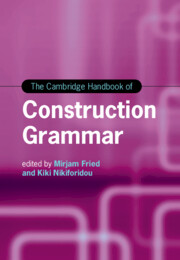Book contents
- The Cambridge Handbook of Construction Grammar
- Cambridge Handbooks in Language and Linguistics
- The Cambridge Handbook of Construction Grammar
- Copyright page
- Contents
- Figures
- Tables
- Contributors
- Acknowledgments
- Construction Grammar
- Part I The Constructional View of Language
- Part II Methodological and Empirical Foundations of Constructional Research
- Part III Case Studies in Constructional Morphosyntax
- Part IV Multimodality and Construction Grammar
- Part V Constructions in Sociocultural and Typological Variation
- Part VI Constructional Applications
- 21 Construction Grammar and Artificial Intelligence
- 22 Construction Grammar and Language Models
- 23 Construction-Based Language Learning and Teaching
- 24 Construction Grammar and Literature
- Index of Terms
- Index of Languages
- Index of Constructions
- References
21 - Construction Grammar and Artificial Intelligence
from Part VI - Constructional Applications
Published online by Cambridge University Press: 30 January 2025
- The Cambridge Handbook of Construction Grammar
- Cambridge Handbooks in Language and Linguistics
- The Cambridge Handbook of Construction Grammar
- Copyright page
- Contents
- Figures
- Tables
- Contributors
- Acknowledgments
- Construction Grammar
- Part I The Constructional View of Language
- Part II Methodological and Empirical Foundations of Constructional Research
- Part III Case Studies in Constructional Morphosyntax
- Part IV Multimodality and Construction Grammar
- Part V Constructions in Sociocultural and Typological Variation
- Part VI Constructional Applications
- 21 Construction Grammar and Artificial Intelligence
- 22 Construction Grammar and Language Models
- 23 Construction-Based Language Learning and Teaching
- 24 Construction Grammar and Literature
- Index of Terms
- Index of Languages
- Index of Constructions
- References
Summary
In this chapter, we argue that it is highly beneficial for the contemporary construction grammarian to have a thorough understanding of the strong relationship between the research fields of Construction Grammar and artificial intelligence. We start by unraveling the historical links between the two fields, showing that their relationship is rooted in a common attitude towards human communication and language. We then discuss the first direction of influence, focusing on how insights and techniques from the field of artificial intelligence play an important role in operationalizing, validating, and scaling constructionist approaches to language. We then proceed to the second direction of influence, highlighting the relevance of Construction Grammar insights and analyses to the artificial intelligence endeavor of building truly intelligent agents. We support our case with a variety of illustrative examples and conclude that further elaboration of this relationship will play a key role in shaping the future of the field of Construction Grammar.
Keywords
- Type
- Chapter
- Information
- The Cambridge Handbook of Construction Grammar , pp. 543 - 571Publisher: Cambridge University PressPrint publication year: 2025
References
- 2
- Cited by

